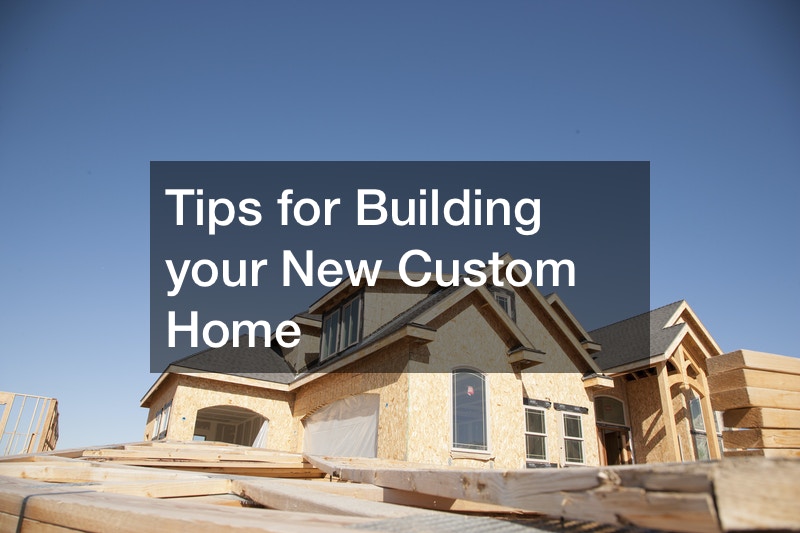
Constructing a custom home is an exciting and enjoyable endeavor to undertake during one’s lifetime. However, in order to successfully complete this endeavor, you must have the proper direction and guidance on how to find custom home builders; otherwise, your happy moments will be filled with panic and confusion. The following are some helpful pits for building your custom home.
Identifying the Site Features
The first step in developing a custom home, and even before designing it, is to identify and purchase suitable land. The external environment of a home should complement your plan to interior design your home.
It is critical to consult with a custom home developer in order to establish certain features that are important to you and that may be affordable and cost less money on your behalf.
Before deciding on a piece of land on which to build your custom home, there are a few things that you should consider in general. One or more of these elements include utility efficiency, stable field conditions, good drainage, being free from soil erosion, being free of sensitive shrubbery and trees, having a good slope that is not steeply sloping, and not having rock outcroppings on the property.
It is, therefore, critical to first gain an understanding of the characteristics of the surrounding area in order to determine the most suitable location for building your custom home with the least amount of expenses and the smallest number of potential difficulties that could complicate the construction of your home.
Identifying a Raw Land
It is critical to consider the purchase of undeveloped land when making a land purchase decision. A raw piece of land is extremely advantageous because it reduces the overall cost of home construction because there are no items to demolish or redesign. As a result, it is critical that you hire a custom home builder to assist you with the land acquisition process. A good example is a project that does not necessitate the removal of expensive rock or the importation or exportation of goods that could be detrimental to your endeavor.
The availability of sewer and utility hookups should also be considered because obtaining permits for these connections may add time and money to the project’s overall cost and timetable.
Navigation Through a Property with Existing Properties or Houses
The property may be burned down or unfinished in some cases, and the filming of the entire movie may be required in these instances. As a result, one may be forced to navigate through the process of partial or complete demolition of the structures, as well as redesigning the property as a model, which will incur additional expenses. There are some advantages and disadvantages to both, and it is, therefore, necessary to engage a custom home builder to conduct an estimate on the various options to consider before purchasing a piece of land or building a home. As a result, it is critical to understand the impact of an existing home on long-term tax obligations as well as the overall budget for custom home construction.

Coming Up With the Land Development Budget
Developing the overall custom home development budget requires a comprehensive feasibility study on the type of land based on topology, proximity to relevant amenities such as roads, electricity, and water needed for construction, as well as existing fixtures and structures on the land.
The best way to go about the budgeting is therefore to look for an experienced custom home builder to optimize your construction project on the basis of the best cost combinations and potential cost outliers that may be included in the overall budget.
A knowledgeable custom home developer will obviously give you the best options that may pose lower risks in terms of development and redevelopment of land.
Utilities
Before making any purchases of land for your custom home it is important to first of all establish the kind of utilities available on the property.
You need to know whether there are natural gas supplies, water, electricity, phone cable, sewer line, among others.
You need to establish whether you need to install a propane tank, drill a well, and come up with a septic system.
It is also vital to determine whether you need a water tank for your property and whether there is enough water pressure.
Other items that you need to look at are whether you need to bring a fire hydrant to your property or other items such as electrical transformers, or public footpaths.
This is the time to come up with utility questions that can help your custom home building be connected with the essential utilities. It is therefore imperative to engage real estate brokers or agents of land before making any purchases so as to have an idea of all the utilities available and what you need to include in their overall custom home budget.
Government Constraints and Easements
Before making any purchase of land, it is important to consider the government regulations on the basis of the custom home vertical height limit and the limit of your custom home building footprints within a particular locality.
All properties have their own limitations set by the government to regulate the development of buildings which may be a setback or a boost to your home development.
It is important to note that in some cases there are some open space easements that need preservation of all the natural land. A case in point is the Indian burial grounds, which cannot be disturbed and therefore should be considered areas to be preserved naturally by any properties nearby.
There are, however, some cases where this type of easement is not indicated in the property grant deed and should therefore not be overlooked as there are many avenues to establish search records, especially by the building department.
Easements of any property can sometimes be tricky to understand, requiring the experience of a custom home developer to help in the analysis of a specific guide and requirements needed to lessen the complicated process.
You need to come up with the design of your custom home structure entailing how you intend to the exterior and interior design of your home. The design then needs to be submitted to an architectural review board or an HOA in order to understand the constraints that have to be complied with before making any purchases of the land.
The review process will help you establish whether the specific regulations and easements of a place can accommodate your custom home building.

Developing a Vision
Like any other endeavor, coming up with your custom home building requires a vision. It is therefore important to think about the specific features and elements that need to appear as you interior design your home.
Within the design, you need to indicate the size of your custom home, the views, outdoor living spaces, porches, garage, and determine whether it’s a single-story or a two-story building.
To guide you through the process, it is important to come up with a list of the ‘would be nice’ and the ‘must haves’ items.
At this stage, you do not need to develop a floor plan but just indicate the items that you intend to have in the custom home building.
The best plan would come from a custom home designer and developer and may be modified based on the topography and the regulations of land you intend to purchase. Normally, the list of must-haves determines your custom home’s conceptual layout.

Conceptual Design
Conceptual design is one of the critical parts of your custom home design that provides our layout of how to exterior and interior design your home.
Upon completion of the conceptual design, a thorough review and inspection of the design is required.
The first thing to consider when developing the conceptual design is the site. It is therefore important not to rush the design stage of your custom home such as the interior design of your home. It is important to establish side constraints such as the utilities, vertical height limits, setbacks, government regulations, and easements.
At this stage, you should engage the architectural designer to come up with a layout of the house on the target land and, including items such as landscape features, outdoor entertainment spaces, pathways, patios, swimming pool, neighboring properties, the direction of the wind, views, and sun orientation.
You need to incorporate their site features in your overall master plan when you exterior and interior design your home.
The best approach is to engage an expert custom home designer to put the features in place and make your home stylish, comfortable, and functional with an architectural style that you prefer.
Cost and Budgets
Developing the cost and budgets of your custom home is a complex process that requires expertise and understanding of the different disciplines.
It is imperative to identify the cost of permits, title 24, construction documents, product selection, and design.
It is also important to factor in the professional consultants’ costs, as well as the county and city fees, land development costs, the cost that goes to the project when you exterior and interior design your home, and the cost.
Other costs to factor in include pad certification, grading, bio-retention, field sales testing, staking, BMPs, on-site grubbing.
It is, therefore, imperative to engage an expert to provide you with the construction cost estimates. Engaging an expert can help you avoid any cost overruns that come from forgetting areas that need to be factored into the budget and costs.
A licensed professional consultant can help you obtain building permits such as landscape architectural permits, geotechnical engineering, survey engineering, environmental engineering, structural engineering, and civil engineering permits.
The costs and budgets of a custom home may differ depending on the code requirements, the size of the home, the product used, the level of utilities and finish used, and the complexity of the structure.
Before you exterior and interior design your home, it is important to engage an expert or consultants of custom home building to give you informed decisions on the design and process and the costing that can help in the development of an accurate budget for your custom home.
You also need to engage glass contractors to help you establish the cost that goes to the windows and glasses aligned with the plan to interior design your home.
Fence building services will also be required, as well as a local roofing service that would give you a rough estimate of the cost that goes to fencing and roofing.
The other services such as the HVAC services may provide better estimates for your air conditioning.
Another item that a custom home builder might not give you a rough estimate on is the garage door, which may require a garage door repair and maintenance expert.
Piping services may require a plumber to help you establish what items you need to purchase.

Construction and Maintenance
This is the building of a home where you finally put your design into practice. This is a big milestone in having your custom home.
This is why you engage with the construction companies to actualize your design and vision.
This is the stage at which you design the exterior and interior of your home after construction is complete to give it the homey feel you desire.
Upon completion of your construction, consider maintenance services, such as water mitigation, residential pest control services, and an asphalt maintenance service that may make your home a more comfortable living place.
Coming up with a custom home is one of the exciting undertakings in one’s lifetime. It is an opportunity to the exterior and interior design your home by engaging experts to help you overcome the hurdles along the process. From the initial concept of budgeting construction, a custom home development requires certain tips established in this article to help you navigate through the legal, budgetary, and property-related issues.



